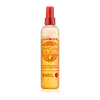What's inside
What's inside
 Key Ingredients
Key Ingredients

No key ingredients
 Benefits
Benefits

 Concerns
Concerns

 Ingredients Side-by-side
Ingredients Side-by-side

Water
Skin ConditioningCyclopentasiloxane
EmollientArgania Spinosa Kernel Oil
EmollientCocodimonium Hydroxypropyl Hydrolyzed Keratin
Skin ConditioningCocodimonium Hydroxypropyl Hydrolyzed Wheat Protein
CleansingHydrolyzed Wheat Protein Pg-Propyl Silanetriol
Skin ConditioningPanthenol
Skin ConditioningDimethicone
EmollientDimethiconol
EmollientDisiloxane
Skin ConditioningPolyquaternium-16
Polyquaternium-6
Gluconolactone
Skin ConditioningLactic Acid
BufferingPEG-12 Dimethicone
Skin ConditioningPhenyl Trimethicone
Skin ConditioningBenzophenone-4
UV AbsorberParfum
MaskingLinalool
PerfumingSodium Benzoate
MaskingCI 14700
Cosmetic ColorantCI 19140
Cosmetic ColorantWater, Cyclopentasiloxane, Argania Spinosa Kernel Oil, Cocodimonium Hydroxypropyl Hydrolyzed Keratin, Cocodimonium Hydroxypropyl Hydrolyzed Wheat Protein, Hydrolyzed Wheat Protein Pg-Propyl Silanetriol, Panthenol, Dimethicone, Dimethiconol, Disiloxane, Polyquaternium-16, Polyquaternium-6, Gluconolactone, Lactic Acid, PEG-12 Dimethicone, Phenyl Trimethicone, Benzophenone-4, Parfum, Linalool, Sodium Benzoate, CI 14700, CI 19140
Water
Skin ConditioningGlycerin
HumectantCetearyl Alcohol
EmollientPropylene Glycol
HumectantArgania Spinosa Kernel Oil
EmollientOlea Europaea Fruit Oil
MaskingAcetamide Mea
HumectantCeteth-20
CleansingOlealkonium Chloride
Stearalkonium Chloride
PreservativePanthenol
Skin ConditioningSimethicone
EmollientDMDM Hydantoin
PreservativeDisodium EDTA
Parfum
MaskingBenzyl Benzoate
AntimicrobialLinalool
PerfumingBenzyl Salicylate
PerfumingLimonene
PerfumingCoumarin
PerfumingAlpha-Isomethyl Ionone
PerfumingWater, Glycerin, Cetearyl Alcohol, Propylene Glycol, Argania Spinosa Kernel Oil, Olea Europaea Fruit Oil, Acetamide Mea, Ceteth-20, Olealkonium Chloride, Stearalkonium Chloride, Panthenol, Simethicone, DMDM Hydantoin, Disodium EDTA, Parfum, Benzyl Benzoate, Linalool, Benzyl Salicylate, Limonene, Coumarin, Alpha-Isomethyl Ionone
 Reviews
Reviews

Ingredients Explained
These ingredients are found in both products.
Ingredients higher up in an ingredient list are typically present in a larger amount.
You may know this ingredient as argan oil. Argan Oil has antioxidant, hydrating, and soothing properties.
Studies have shown argan oil can help fight again radical damage from the sun. This makes it effective at preventing hyperpigmentation.
Large amounts of vitamin E found in argan oil helps the skin retain water. Argan oil also contains fatty acids such as linoleic acid, oleic acid, and palmitic acid. It is also a good source of lipids.
Another benefit of argan oil is skin-soothing. It can help reduce inflammation-related skin symptoms.
Argan Oil is effective at regulating sebum production in pores. This can make it effective at treating hormonal acne.
Traditionally, argan oil was used for its antibacterial and antifungal properties. However, argan oil contains fatty acids that may make it not fungal-acne safe.
Argan Trees are native to Morocco.
Learn more about Argania Spinosa Kernel OilLinalool is a fragrance and helps add scent to products. It's derived from common plants such as cinnamon, mint, citrus, and lavender.
Like Limonene, this ingredient oxidizes when exposed to air. Oxidized linalool can cause allergies and skin sensitivity.
This ingredient has a scent that is floral, spicy tropical, and citrus-like.
Learn more about LinaloolPanthenol is a common ingredient that helps hydrate and soothe the skin. It is found naturally in our skin and hair.
There are two forms of panthenol: D and L.
D-panthenol is also known as dexpanthenol. Most cosmetics use dexpanthenol or a mixture of D and L-panthenol.
Panthenol is famous due to its ability to go deeper into the skin's layers. Using this ingredient has numerous pros (and no cons):
Like hyaluronic acid, panthenol is a humectant. Humectants are able to bind and hold large amounts of water to keep skin hydrated.
This ingredient works well for wound healing. It works by increasing tissue in the wound and helps close open wounds.
Once oxidized, panthenol converts to pantothenic acid. Panthothenic acid is found in all living cells.
This ingredient is also referred to as pro-vitamin B5.
Learn more about PanthenolParfum is a catch-all term for an ingredient or more that is used to give a scent to products.
Also called "fragrance", this ingredient can be a blend of hundreds of chemicals or plant oils. This means every product with "fragrance" or "parfum" in the ingredients list is a different mixture.
For instance, Habanolide is a proprietary trade name for a specific aroma chemical. When used as a fragrance ingredient in cosmetics, most aroma chemicals fall under the broad labeling category of “FRAGRANCE” or “PARFUM” according to EU and US regulations.
The term 'parfum' or 'fragrance' is not regulated in many countries. In many cases, it is up to the brand to define this term.
For instance, many brands choose to label themselves as "fragrance-free" because they are not using synthetic fragrances. However, their products may still contain ingredients such as essential oils that are considered a fragrance by INCI standards.
One example is Calendula flower extract. Calendula is an essential oil that still imparts a scent or 'fragrance'.
Depending on the blend, the ingredients in the mixture can cause allergies and sensitivities on the skin. Some ingredients that are known EU allergens include linalool and citronellol.
Parfum can also be used to mask or cover an unpleasant scent.
The bottom line is: not all fragrances/parfum/ingredients are created equally. If you are worried about fragrances, we recommend taking a closer look at an ingredient. And of course, we always recommend speaking with a professional.
Learn more about ParfumWater. It's the most common cosmetic ingredient of all. You'll usually see it at the top of ingredient lists, meaning that it makes up the largest part of the product.
So why is it so popular? Water most often acts as a solvent - this means that it helps dissolve other ingredients into the formulation.
You'll also recognize water as that liquid we all need to stay alive. If you see this, drink a glass of water. Stay hydrated!
Learn more about Water